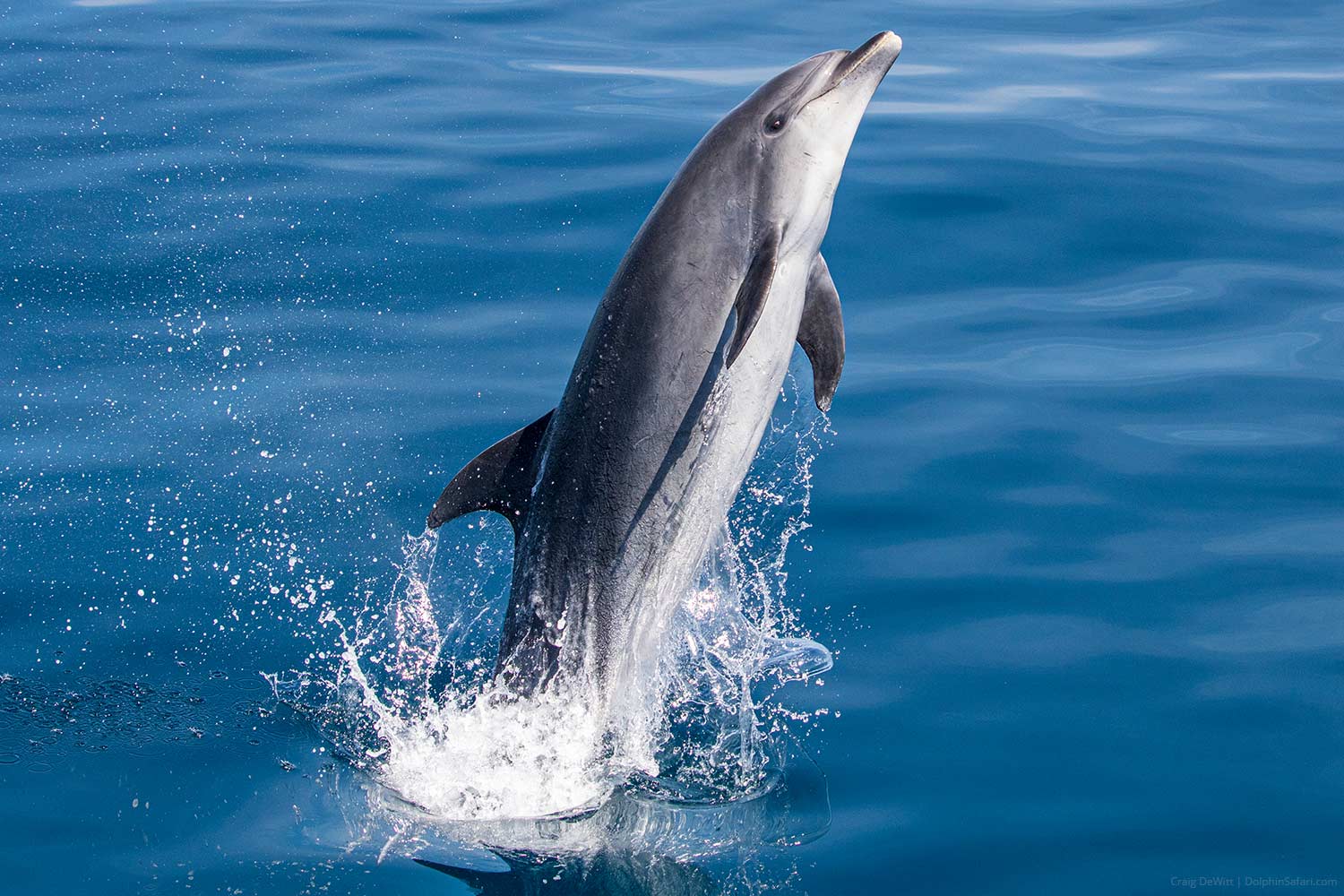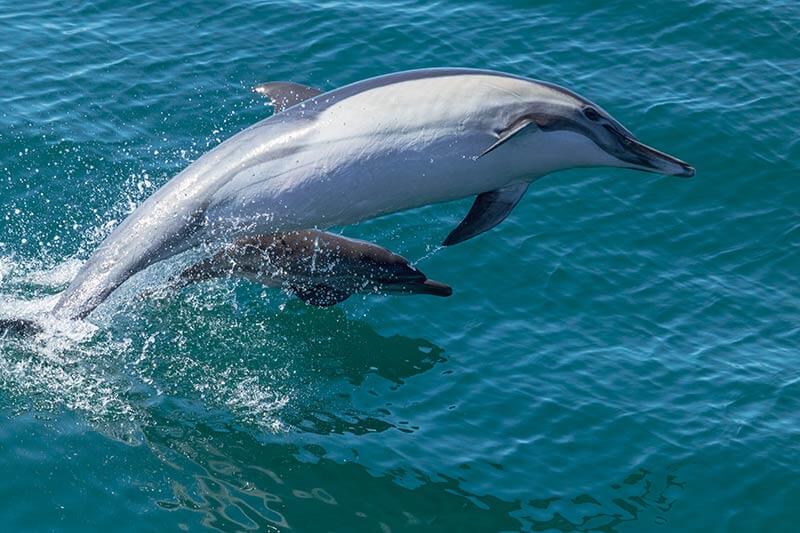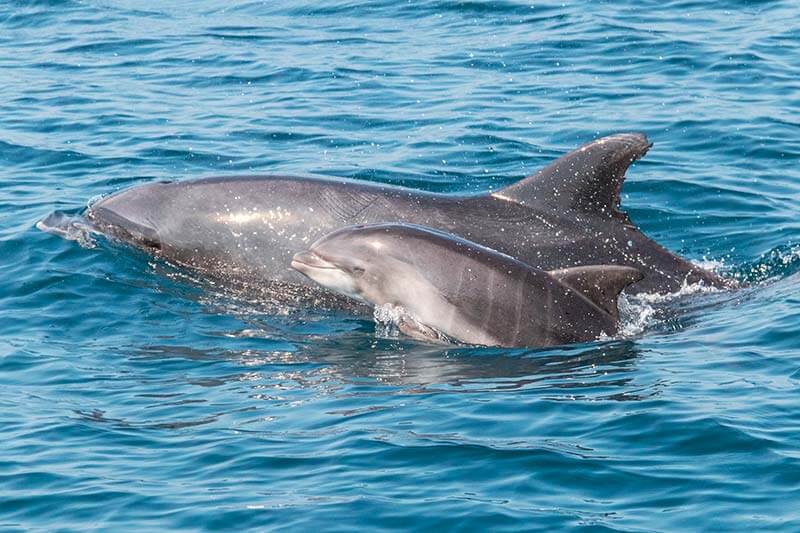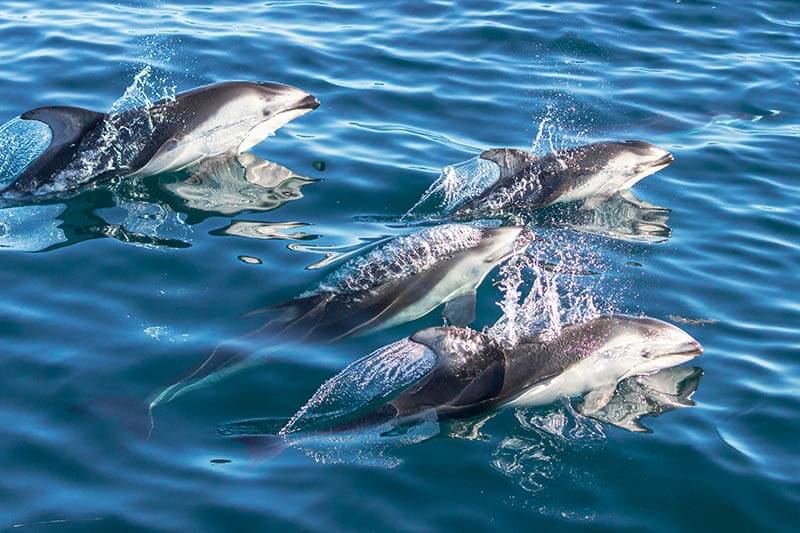Five Different Types of Dolphins in Dana Point

Did you know that all dolphins are whales but not all whales are dolphins? There are 49 different types of dolphins and porpoises and these species are grouped into six families. Let’s break it down: the largest with 38 members is the oceanic dolphin family; next is the porpoise family with seven members and there are four river dolphin families, each containing just one species and typically found in places like India, Bangladesh and Nepal.
If you are wondering which whales are also types of dolphins in Southern California, we can help. It is easy to get confused if you are looking at their name alone, because there are eight dolphin species that feature the word “whale” in their classification names. We know, confusing right? These toothed members of the dolphin family include pilot whales, false killer whales and melon-headed whales. We are lucky to see so many different types of dolphins in Southern California and many of them are quite common to our waters, although nothing is common about these beauties!
On any given day we have the opportunity to catch a glimpse of multiple species of cetaceans. In fact, no other place in America has more species of dolphins and whales who visit one place! To remind you just how special this place is, there are only three places on earth that have such varied groups living amongst one another. The different types of dolphins we often see in our waters include two species of common dolphins, one species of bottlenose dolphins, the beautiful Risso’s dolphins, who are unlike anything else out at sea, and our beautifully painted regal winter guests, the Pacific white-sided dolphin.
Common Dolphins

The most commonly seen type of dolphins in Southern California are the common dolphin or Delphinus delphis from the family Delphinadae. Common dolphins are the most abundant of all of the dolphin species, hence their name, with well over 1 million living in the world today. In Dana Point, California we are lucky to have over 450,000 common dolphins who call this beautiful place on earth their home too. Common dolphins are broken out into two species, the short-beaked common dolphin and the long-beaked common dolphin. While their name sounds similar, they are in fact different types of dolphins. Gregarious, social, and always gorgeously dressed in their characteristic hourglass two-tone coloring, both of these species will travel in large family groups called pods. When multiple family groups combine we call these groups herds and these herds can be spotted in hundreds, thousands and have been recorded up to ten thousand too! From the boat, we look for lots of splashing in the water and a glimpse of their tall, triangular dorsal fin set in the middle of their sleek dark back. When we see these incredibly active marine mammals there is not a bad seat in the house!
Common dolphins are one of the different types of dolphins who often swim up to check us out and will often decide to stay and have some fun of their own. Using the pressure of the waves, they love bow riding and can be seen enjoying the propulsion of the wake of our stern. They can soar to new heights with jaw dropping high flying acrobatic leaps out of the water to show off their beautiful almond shape hourglass color patterns and yellow undertones on both the right and left sides just forward their dorsal fin and will even swim upside down to give us a peek of their white underbellies.
While the short-beaked common dolphin and long-beaked common dolphin may be different types of dolphins, they also have many similarities too. Both species are a type of dolphin in Southern California weighing between 180 – 500 pounds with males being slightly larger than their female counterparts in both species. Short-beaked common dolphins are more robust and also slightly smaller than their long-beaked relatives, measuring in at six feet long which is relatively small when compared to the long-beaked common dolphin who reach lengths of 6 to 8.5 feet long. With age comes beauty so the more mature adults will have more prominent coloring whereas the youngsters are often much lighter in color. One additional marking difference between these different types of dolphin species is the dark colored cape that covers the eye area of the long-beaked, whereas it does not cover the eye area of the short-beaked common dolphin.
Risso’s Dolphins

Grampus griseus is a scientific name given to a dolphin species who are often shy around boats, but is just as unique as the striking markings they possess. Risso’s dolphins are probably the most unique type of dolphin in Southern California due to their discolored markings. This species is born dark gray, black and even brown and their color will change over time into a pale gray and almost white tone as they age, much like us!
When this different type of dolphin is spotted by passengers, the first question that quickly comes to mind is, “Why do Risso’s dolphins have these markings?” The answer is an easy one for this chaotically colored mammal. Scarring from daily social interactions with dolphins within their own pods, as well as tattoo-like scarring leftover from eating their favorite item on the menu, the cookie cutter shark, give Risso’s their unique markings. Circular white scarring patterns on their skin are telltale signs of encounters with squid, another Risso dolphin “favorite” when ordering off the ocean’s à la carte menu. Different types of dolphins feed at different times of day depending on what they are feeding on but since the Risso’s diet consists mostly of deep ocean dwellers, they are typically nocturnal eaters when their food is most active.
Risso’s dolphins have more of a rounded square-shaped bulbous head, much like that of a pilot whale, with no distinguishable beak, and are much larger than the common dolphins we talked about earlier weighing roughly anywhere from 660 to 1,110 pounds. Typically, Risso’s dolphins will reach lengths of up to 13 feet and will reach their sexual maturity around 8-10 years. Between twelve and eighteen months baby calves will begin to wean from their mothers when they are old enough to be able to leave with the pod. As a result these are one of the different types of dolphin who have a more lengthy stay with mom. Risso’s gestation period lasts between 13 and 14 months and will only give birth to one offspring at a time. Like all dolphins and whales, babies are born in what we think of as a breech position with a baby’s fluke delivered first in order to protect the fragile newborn’s blowhole and to prevent drowning their young. These beauties will give birth every 2.5 years and little one’s are born weighing approximately 40 pounds on day one.
Their visits are always exciting for passengers and captains and crews alike out of all of the different types of dolphin encountered! Found in various temperate and tropical waters all over the world, Risso’s Dolphin are one type of dolphin in Southern California who prefer offshore deep waters, where they can hold their breath for up to 30 minutes while diving to depths of up to 1,000 feet below the surface. The fairly tall and curved dorsal fin of the Risso’s Dolphin can be spotted well above the surface which makes this type of dolphin in Southern California an easy and favorite one to spot.
Bottlenose Dolphins

There is one type of dolphin in Southern California that is most certainly the most recognizable to the masses and that is the bottlenose dolphin or Tursiops truncatus. Originally made famous by the TV show “Flipper”, bottlenose dolphins always bring a contagious dolphin smile everywhere they go. There are two different types of dolphin species comprising the bottlenose dolphin family and both can be seen on any given day here in Dana Point, California. Both species are extremely similar in characteristics and have the same countershading coloring with white underbellies and gray on their back. These highly intelligent ocean cetaceans are an absolute favorite sighting amongst passengers. Like all Odontecetes, toothed whales are all about family and the bottlenose dolphin is no exception. They interact with one another as a form of play, they love and fight (and “make up”) and more sweetly, they will also mourn the death of their loved ones much like we do in times of loss. They will even hunt in packs and work together to form elaborate strategies to corral fish into tight bait balls in order to ensure everyone in the pod receives their equal and fair share of the food. One attribute that is the same across all of the different types of dolphin species is that they are all highly intelligent. Did you know that all types of dolphin in Southern California and across the globe have a slick rubbery texture to their skin? You may have known that cool fact, but something that could surprise you is that a bottlenose dolphin’s outermost skin layer can regenerate and be replaced every two hours!! That is nine times faster than that of human skin, keeping their bodies sleek and free to reach high speeds under the water.
Coastal bottlenose dolphins are usually smaller and form very small groups. They can often be solitary visitors while visiting our waters and make their way into our harbor opportunistically looking for smaller schooling fish or remnants from the fisherman’s bait boat. Their offshore counterparts are typically much larger and form groups of 10-25. This dolphin species can be found in larger groups of 50 to several hundred and can sometimes be seen travelling with pilot whales and Risso’s dolphins as they all hunt for their favorite prey, squid. Reaching sexual maturity is reached at different ages for different types of dolphin and typically females reach this point earlier than males. This is true for bottlenose dolphins too. Babies are born approximately 30-40 pounds and 36”- 48” long before reaching lengths of eight to twelve feet and can weigh upwards of 1,000 pounds. In the wild, these gorgeous, gregarious, and friendly creatures can live up to 40 years out at sea with some females outliving males and reaching well into their 60’s. Sadly, this species is amongst the most common captive species found in hotel tanks, amusement parks, and oceanariums throughout many countries and are sought after for their ability to be trained to do high flying tricks that show off their amazing acrobatic skills.
Pacific White-sided Dolphins

Another type of dolphin in Southern California waters who often graces our presence on our passenger boats throughout the winter months is the Pacific white-sided dolphin or Lagenorhynchus obliquidens, or “lags” for short. This dolphin is a different type of dolphin than others in its family in that they are named for their elegant white contouring along their sides underbelly and dorsal fin with white stripes that extend from above the eye along the sides, widening towards the tail. These stunning ocean dwellers have a tall and sharply hooked dorsal fin.
Much like the bottlenose, these dolphins are FAST! Energetically swimming and riding the pressure of the waves of the bow for extended periods of time is one of their favorite play activities. They are also very active and are commonly seen breaching, proposing, and and showing off their high flying acrobatics and aerial somersaulting skills. Like offshore bottlenose and Risso’s, the Pacific white-sided dolphin also eat squid and small schooling fish such as anchovies, herring, sardines and will travel in large herds of up to 100 in search of prey. This species is a type of dolphin in Southern California that we often encounter intermingling with larger rorquals in the area such as fin whales, as well as different types of dolphin like bottlenose and Risso’s.
Between the ages of seven to nine is when a female Pacific white-sided dolphin will reach sexual maturity and then begin to breed. Her gestation period will last 8-10 months and she will not have another baby for another four to five years. Typically, these wild dolphins will live into the 40’s however like all dolphins, their lifespan is cut short due to environmental hazards like ocean noise, and while no longer fished for their meat, they can become entangled in commercial fishing nets. Their main natural predator is the killer whale.
Killer Whales & Other ‘Blackfish’
Largest in the dolphin family and most distinct and visually different type of dolphin is the orca or Orcinus orca. Their black and white camouflage coloring sets them apart from all other animals in the sea. No other animal on earth hunts the orca, or commonly called killer whale. Humans stealing young orca for an aquarium are this animal’s biggest threat. They are the apex predator of the sea and have won the gold medal for being atop the ocean food chain. Surpassing all others with their supreme intelligence with the largest brain on earth, surpassing that of the sperm whale, these supreme beings communicate using their own dialects and have passed down behaviors using their own family languages. We are often asked if we see this type of dolphin in Southern California. A sighting of these different types of dolphin lovingly termed the “black and whites” is one that we consider a rare but an amazing sight to see and does happen every now and again with about 1 in 500 trips logging in a sighting.
Killer whales belong to a very important category of toothed whales called Blackfish which also includes both pilot whales and false killer whales. While pilot whales have been spotted in Dana Point, California, their visits remain few and farther between and are some of the most special. False killer whales tend to love Mexican waters to our south, but over the years have also paid us a visit and a pod of these different types of dolphin came to see us in a herd size of about 40, spotted as recently as March of 2021.
Dana Point, the Dolphin and Whale Watching Capital of the World®, is a spectacular place to see several different types of dolphin in their own free and natural habitat. This marine playground is by far and away the very best for enjoying a vast variety of marine life too. Named as the first ever Whale Heritage site in the Americas, the plethora of marine life in this area is one of the most important reasons this stretch of ocean is a much desired vacation destination location and a perfect spot to book your whale watching trip out at sea. Booking a trip with Capt. Dave’s Whale Watching and Dolphin Safari gives you the chance to see any of these spectacular species, and provide the opportunity for a dolphin dream to become a reality too. We can’t wait to connect you with these animals and have you aboard!
